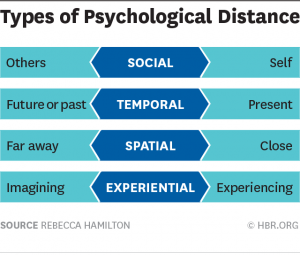When we think about communication, we tend to think in terms of what we say and how we say it. While clearly the what and the how matter, equally important is our ability to bridge the gap, what psychologists have labeled psychological distance— gaps between ourselves and other people (social distance); the present and the future (temporal distance); our physical locations (spatial distance); and imagination and actual experience (experiential distance).

In this HBR article, Rebecca Hamilton, suggests we use two specific strategies to reduce—or sometimes increase— psychological distance and thereby improve outcomes.
First, she suggests we move from abstract to concrete. In the case of temporal distance, for example, we can shorten the time frame. If we give ourselves less time to make a decision or take action, we are less likely to over analyze or procrastinate. Conversely, if we want our team to take more responsibility, we could use more-abstract language, challenge them to develop ideas for increasing revenue instead of asking them to close more deals.
Second, Rebecca suggests we consider substituting one for the other. When searching for common ground during a negotiation, one might use temporal distance by setting a deadline perhaps when there isn’t one. We aren’t doing anything to change the social distance —we don’t feel closer to the other person—but the urgency of reduced temporal distance may alter how we and they approach the deal.
Perhaps the most obvious substitute for spatial distance is social distance. If you are physically separated from people you’d like to influence—customers or colleagues—you can reduce that distance not only with a face to face meeting but also by emphasizing your common attributes and interests. Zappos makes a point of connecting with geographically distant customers by listing the Zappos Family Core Values on its website and sharing photos of the teams who work to deliver orders. You can narrow the spatial gap with far-flung colleagues by connecting on a personal level at the beginning of phone calls or e-mails and, when possible, using video calls.
As leaders, we face challenges related to social, temporal, spatial, and experiential distance every day. The more we can understand the common thread that links each of these and then learn to either adjust the distance or substitute one type for another, the more successful we will be with our communication.
Are You a CEO or President of a Privately Held Business? If you are also a lifetime learner and want to learn more about my Vistage Group, click here
 The initial results of my Pivot are excellent. I feel I have much greater clarity regarding the next 3-5 years..
The initial results of my Pivot are excellent. I feel I have much greater clarity regarding the next 3-5 years.. 